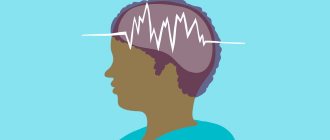Speed, or “speed,” is a synthetic drug of the amphetamine group with a psychostimulating effect that is quickly addictive. It didn’t get this name by accident. After consumption, it provokes an immediate release of hormones and changes consciousness.
The drug is dangerous due to the formation of psychological dependence. It usually doesn’t reach the point of compulsive (physical) syndrome: drug addicts either die or end up in clinics. It is possible to get rid of addiction to “speed” forever after long-term use only with the help of specialists from a drug treatment center. Treatment for speed addiction takes 4-6 months.
How it affects the body
By “speed ” we mean amphetamine with impurities that drug dealers add for profitable sales. The narcotic substance is a phenylalkylamine derivative, a synthetic analogue of joy hormones. The mechanism of action is due to the release of norepinephrine and dopamine - hormones of rage and pleasure that affect the psyche.
A distinctive feature of “speed” is its double effect. 20 minutes after administration, the drug trip begins. The change in consciousness lasts from 30 minutes to 2 hours. The time interval depends on the purity of the product and the technology of use. Then the decline begins. A person first falls into euphoria, then excitement gives way to anxiety and anger.
Methods for receiving speed:
- smoking mixtures;
- drawing in powder through a tube;
- mixing with drinks;
- intravenous injections;
- inhalation of vapor with a narcotic substance through an inhaler.
The penultimate method is the most dangerous. The psychotropic substance enters the brain in a matter of minutes and sharply causes mental arousal.
Smartphones are for the poor
Back in the 90s, pagers and mobile phones were symbols of luxury and prosperity. Today, the pager is a relic of the past, and every second inhabitant of the planet has a smartphone. The world has changed, now a sign of success is considered to be the abandonment of digital devices, and real life is replacing them. Nellie Bowles, a reporter for The New York Times, wrote in her column that rich people can afford face-to-face communication, but the digital world of the future is the lot of the poor. The article caused a lot of discussion, but the fact is undeniable that the modern digital economy is oriented and shaped by the needs of ordinary people - smartphones have ceased to be synonymous with wealth, residents of the poorest countries have access to mobile applications and the Internet.
According to Nellie Bowles, the desire for digital services is a sign of social and economic failure. And vice versa - human contact is rapidly growing in price, but not everyone can afford it. Let's say that rich people have no need to play virtual wars or spy on the beautiful lives of stars. They create this life themselves without being tied to gadgets and the Internet. And today it is considered a real luxury.
It's worth remembering that Steve Jobs, who created the iPhone empire, stated in a 2011 interview with The New York Times that he banned his children from using the newly released iPad. “We limit the amount of technology our kids use at home,” Jobs told reporters at the time. The same situation can be seen in the families of many employees working in Silicon Valley - many Facebook and Google employees do not allow their children to use certain devices.
This approach is based on parents seeing first-hand how much time, money and effort companies spend to make digital technologies increasingly attractive. And they know what technologies can cause addiction to smartphones and programs. The problem is that any activity comes down to the child sitting in front of the screen. Rich people are gradually closing themselves off from this, says Nellie Bowles. They send their children to private schools that do not use gadgets as a learning tool. Wealthy people want their children to play with real toys and study in private schools, where there are a minimum of gadgets in the classroom - where learning is based on live communication with each other.
Stages of speed dependence formation
Synthetic substances affect the nervous system, just like natural endorphins. However, due to the high concentration of the active component, they instantly change the biochemistry of the brain. After taking it, the psychological state improves for a short time and causes pleasant excitement. Pleasure centers remember sensations, and when negative emotions appear, they remember how they can increase their mood levels.
“Aid” changes the course of chemical reactions, reduces or completely stops the production of one’s own joy hormones. Maintaining psycho-emotional balance after each dose becomes more difficult. A person experiences despair, emptiness, pain. Because of this, the portions become larger and the frequency of receptions increases. Addiction to “speed” depends on the frequency, dose and method of use. With intravenous administration, pathological cravings form after 4-5 infusions, with oral administration - after 20-25 days.
Getting ready for “persuasion therapy”
The essence of therapy is to reach a chemically dependent person, to show him the real picture of the breakdown that is happening to him. After all, he convinces himself that there is no dependence, and he will always find something to explain the occurrence of his problems and a series of troubles.
Having broken through the wall of self-deception, you must act immediately. A method of treating addiction, a rehabilitation center, must already be chosen, and the patient is immediately taken there as soon as he realizes that a problem exists.
The body's reaction to "speed"
After taking speed, the drug addict feels a surge of energy and becomes hyperactive. He moves a lot, speaks quickly, gesticulates, making the same movements. Then positive emotions and delight are replaced by anger and wild aggression. Signs of drug intoxication:
- tremor;
- detached look;
- excessive self-confidence;
- attacks of paranoia;
- liberation;
- increased libido.
At the same time, the following are noted: clarity of mind, concentration, thirst for activity. Due to strong psychological arousal and an influx of energy, drug addicts lose appetite and sleep, depleting the body's resources to the limit.
Health implications
When a person uses mephedrone for the first time, he feels a powerful surge of vitality and energy. While in this state, the addict becomes easy to communicate, talkative and cordial. It is easy for him to be the center of attention and become the soul of any company. This property made the drug popular in youth gatherings. However, the euphoria quickly passes, and the damage done to the body is difficult to repair. Each new dose destroys human health:
Mental
The use of mephedrone destroys a person’s mental health. The nervous system is strongly influenced by the drug, introducing a person into severe apathy, provoking schizophrenia and paranoia. There are a lot of suicides among mephedrone addicts.
Most often, from the mental side, the use of mephedrone leads to the following consequences:
- Impaired concentration.
- Reduced critical thinking.
- Manifestation of eccentric behavior.
- Sleep disturbance and sleep paralysis.
Physical
Long-term use of mephedrone is dangerous because the substance disrupts the functioning of all internal human organs that are important for full life. The first thing that gets hit is the heart. Phlebitis, heart failure, thrombosis, and ischemia often occur in addicts. The functioning of the respiratory system is disrupted. The liver is destroyed in a short time under the influence of toxins, and a malfunction of the gastrointestinal tract is observed. Mephedrone leaches calcium from bones and joints, making them brittle.
What happens during an overdose
For the sake of a long-term psychedelic trip, “amphetamine marathons” are often held at parties. Drug addicts immediately take 2-3 doses, which provide a stimulating effect for 5-12 hours. The kidneys and liver, when consuming 10-15 mg of the substance, can still resist intoxication, but with a double dose they cannot cope with toxins. Exceeding the drug dose or frequency of administration leads to serious complications. Following the psychostimulating effect:
- blood pressure rises sharply;
- convulsions and vomiting appear;
- heart rate increases;
In the absence of timely assistance, an overdose can lead to collapse of the heart and brain. In addition, people with an active psyche often develop psychosis and delusional hallucinations.
Drug addiction?
Get a consultation now
Mephedrone trip. How addiction develops
The effect of mephedrone is often compared to an amphetamine trip. After consuming a dose, the level of dopamine and serotonin in the body increases. His mental and physical activity goes beyond the limits of the possible, his sympathy for people increases, and he strives to communicate.
The use of mephedrone very often develops into a persistent dependence on the drug, where the most important danger is the psychological attachment to the effect of the surfactant. In case of withdrawal from the drug, painful physiological symptoms appear, since the substance has a strong effect on all internal organs, especially on the skeletal and cardiovascular systems.
The following stages of addiction are distinguished:
- First use. Random or careful testing with positive impressions.
- Regular intake of up to 5 doses per month. Tolerance is formed, the dose is taken not only in company, but also for one’s own personal pleasure. Gradually the dosage begins to increase.
- Regularity of use depends on the ability to purchase surfactants. The dose increases with each new use of mephedrone. The effect feels incomplete and brings disappointment to the addict. At this stage, most often they begin to inject mephedrone in an attempt for a more dramatic effect.
- A new dose of mephedrone, like an obsession. Under the drug, the addict wants to be everywhere. Often this stage lasts up to 2 years and results in major health problems. The desire to use drugs becomes irresistible.
Addicts, obsessed with finding a new dose, almost never think about how harmful mephedrone is to their health.
Is it possible to get rid of a bad habit on your own?
Amphetamine addicts think that they can stop taking the dose at any time. However, due to the disruption of biochemical processes in the body that caused addiction, it is impossible to solve the problem without medical help. When you quit AIDS, withdrawal symptoms occur. When breaking:
- a person cannot keep warm;
- cold sweat appears on the skin;
- a runny nose bothers you;
- severe pain appears in the muscles.
In this state, the addict does not always recognize loved ones. At the same time, he experiences weakness, drowsiness, and gets tired quickly. This is caused by starvation, nutritional deficiency. To alleviate the condition, relatives give him mineral water or green tea, milk, and activated carbon. But these measures yield almost no results. He cannot cope with the pain and asks for a dose. Looking at the physical suffering, relatives make concessions. After the next dose of a psychotropic, the addict quickly comes to his senses, and everything begins in a circle. As long as the addict is around codependent people, this will continue for a long time.
To overcome amphetamine cravings, you need to hold out for several weeks after withdrawal. However, strong desire overcomes reason. After a break, the addict usually begins an “amphetamine marathon.” After refusal, a more severe withdrawal occurs, which you can no longer cope with on your own.
To help, change yourself
In order to somehow live next to an addicted person, loved ones often take on certain roles, thus protecting themselves psychologically. It seems that this is how you can cope with the problem, but this is an illusion. Please note, maybe your role is also written here?
Role "Protector"
Behavior in this role can be compared to the behavior of the mother of a small child. Firstly, you always have to apologize for the terrible behavior of the deranged “child” in front of others. Secondly, make excuses to your boss for absenteeism and inappropriate behavior at work. And thirdly, to always be on the side of your client, that is, to support all versions of his ever deeper immersion in addiction.
\
When a person takes on these “responsibilities”, he begins to lose respect for himself. Consciousness seeks protection and finds it in the unwillingness to acknowledge reality. As a result, it begins to seem to the “defender” that all the addict’s explanations about why he drinks or takes drugs are completely true. And now he already believes that everything is not so scary and will soon pass on its own, and the ward will come to his senses. And at this time the disease progresses, and the patient becomes more and more angry with himself, but projects this anger onto others. The addict humiliates his “protector” more and more, and the latter sinks deeper and deeper into the abyss of guilt for the addiction of a loved one.
The worse he feels about himself, the stronger his defensive reactions begin to work. Now the performer of this role himself, wanting to get rid of negativity towards himself, proves day after day that he is an ideal spouse and parent. The wall of self-deception is now growing before the eyes of the “defender”; the disease has affected him too.
Role "Controller"
As self-respect leaves a person living next to a drug addict or alcoholic, the conviction grows that the blame for such a “coincidence of circumstances” lies entirely on his shoulders. Wanting to grow in his own eyes, the addict’s loved one takes on the role of “controller.” Now he believes that he must continuously monitor the progress of the patient’s life. As a result, the “controller”, wanting to reduce the use of psychoactive substances, may start drinking with the ward, or buy alcohol or drugs on his own. Now he refuses invitations where “dopings” are expected to be used, monitors the patient’s “stash” and throws them away. We have to control finances and regularly beg the addict to stop drinking, reminding them of the suffering of loved ones.
The dependent person continues to experience uncontrollable anger towards himself, but transfers it to the “controller”, who is once again convinced that he is the root of the problem. The circle closes. They try to cut down on the patient’s ability to get a “high,” but he finds dozens of ways to get many times more of it. This makes the “controller” increasingly dissatisfied with himself, so he intensifies his attempts to limit the consumption of alcohol or drugs.
Role "Accuser"
When there is no strength left to control, self-disappointment has reached its apogee, you want to give up everything, and before that tell the chemically dependent person what a nonentity he is and how much he ruined the life of his family. More and more often there are groundless threats to leave and not return, accusations of lack of willpower in the face of the temptation to use drugs, ridicule of ridiculous excuses. The “accuser” is already in captivity of a loved one’s addiction, his mental health is under threat, his mood is constantly changing from a state of complete depression to irritability and anger. There is no positive attitude in this scale of fluctuations. Despair is a constant companion of the “accuser”; it does not allow you to look at the problem soberly; your eyes are clouded by resentment and lack of faith in yourself as a fighter against the disease.
Role "Loner"
It begins to feel like the fight against your loved one’s addiction lies solely on your shoulders. The “loner” defends himself and defends against the patient’s surroundings. He does not seek support, and only enemies are seen around him. As a result, there are indeed fewer and fewer empathizers, because it is increasingly difficult for those around them to communicate with the defenders on all fronts.
Role "Conniver"
This role follows from the previous ones quite logically. With all his actions, seemingly aimed at good, the caregiver of a dependent person only aggravates his illness. Now the patient is protected from attacks from the outside world, he has someone who can be accused of regular use of psychoactive substances (“if my wife didn’t nag me, I would drink less”), this same person has taken upon himself all the functions of supporting the addict’s life. You can relax and use the drug once again, there are no consequences! It turns out that “noble” actions led to the opposite effect, and the role of “connivance” was born.
Role "Codependent"
This is, in principle, no longer a role... The disease has taken root, and the wrong attitude towards chemical dependence, the wrong positions in relation to it, have yielded depressing results. Dependence progresses in one person, and people close to him fall into codependency. They are divorced from reality, they can only suffer alone without help, pitiful and angry at each other.
Treatment methods for speed addiction
To quickly relieve symptoms of withdrawal, detoxify, and restore body functions, medical assistance is needed. Treatment for speed addiction includes 3 stages:
- elimination of withdrawal syndrome (withdrawal);
- comprehensive cleansing of the body;
- rehabilitation course.
Quitting a psychostimulant is only the first step to a healthy life. First you need to remove acute symptoms, remove toxic decay products from tissues, organs, and adipose tissue. For blood purification, extracorporeal methods are used - plasmapheresis and hemosorption.
- The first method consists of collecting blood and separating it in a special apparatus - a plasma filter or separator into plasma and red cells. The liquid part of the blood (plasma) is removed, a replacement solution is added instead, mixed with blood cells and poured into the bloodstream.
- The second involves pumping blood under pressure in a blood machine through a sorbent. Passing through carbon or ionic resins, poisons remain on the surface.
To restore the function of systems and organs, immunity, and metabolic processes, medications and vitamin therapy are prescribed. Medicines are selected by doctors depending on the damage to the organs and the general condition of the patient. To maintain the nervous system and stabilize the psycho-emotional background, addicts are prescribed:
- nootropics;
- sedatives;
- tranquilizers.
Psychotherapy
In parallel, psychologists work with patients. Professional support makes it easier to endure cleansing and to realize the need for rehabilitation. Communication with a resident allows specialists to collect primary information and make behavioral and social diagnoses.
Various methods of psychotherapy are used to work with patients. One of the successful practices is Gestalt therapy. Situation modeling helps:
- objectively assess the problem;
- give vent to feelings, emotions;
- relive an exciting event again, replaying it differently.
Transactional analysis is effective in identifying ineffective behavior patterns. formed in childhood or adolescence. The psychologist leads the patient to realize mistakes and identify the cause-and-effect relationship of actions. Cognitive-behavioral, art therapy, and psychodrama are also used for treatment.
After analyzing behavioral scenarios and working on themselves, patients acquire open communication skills, can navigate reality, and solve interpersonal problems. People get rid of complexes of victims, losers, social phobias, and gain confidence.
The role you need. "Interventionist"
This is the role that is truly needed to combat addiction. But it is necessary to resist and fight, and the patient’s relatives are able to do this if they approach the problem correctly. From the above, we can draw the following conclusions: it is impossible to protect the patient, to deceive yourself that this is temporary, extremely dangerous, to mitigate the fact that there is an addiction is unforgivable!
You need to start learning this role with the understanding that chemical dependence is a disease. Relatives do not blame themselves if their relative catches a viral disease; they take reasonable steps for his recovery. The family of a drug addict or alcoholic should do the same. Remember how a child behaves when he has a fever and his whole body is covered with a rash? He is capricious, does not want to take medicine, calls in every possible way to take pity on him and surround him with attention and care. Why won't you give medicine if he doesn't want it? Or will you not treat the rash with a skin-stinging lotion? Of course, emotions cannot be avoided. But the parent follows the doctor’s orders, without unnecessary sentimentality or persuasion.
So, you should stop delicately hinting that there is an illness, or solving problems related to his addiction for the addicted person. Let him face the truth: he is becoming antisocial and dangerous to the family.
Working with relatives
Rehabilitation centers work with codependents. Codependency refers to the psychological connection between the addict and family members caused by empathy and guilt. As a result of adapting to a traumatic situation and reacting to stress, healthy people develop a special mental state. They concentrate on the problem, become isolated on it, and stop taking care of themselves and living their own lives.
Addictologists, specialists in eliminating codependency, and psychologists work with them. They conduct group educational lectures, family psychotherapy in a group or individually. Working with a specialist, learning skills to deal with stress, and other psychotechnics help people get rid of destructive feelings and switch to themselves. Only a professional approach to the problem will help cope with withdrawal symptoms after giving up “speed” and solve the problem of addictive behavior. Doctors give every drug addict a chance to return to an active life and enjoy the process without amphetamine.
Convince yourself and convince others
Vernon Johnson's book "How to Get a Drug Addict or Alcoholic to Treat" should be on the table in a family where a terrible illness has been discovered. In it, the author talks not only about sick people, but also about their still healthy environment.
Upon learning that such a disease has come to the family, it is impossible not to experience despair, anger, disgust or fear. Everyone today understands that drugs often result in the death of the addict. This is a constant threat to family members: diseases carried by the drug addict, his inappropriate behavior and aggressiveness. It is very difficult to help a drug addict and live nearby. Sometimes you don’t even want to. After all, he himself does not see problems and does not recognize dependence. Therefore, the disease often brings its victim to the extreme point of despair, when the drug does not bring pleasure, but only temporary relief from withdrawal. Then, wanting to get rid of withdrawal symptoms, he agrees to treatment or initiates it himself. But this does not mean that he will stop taking drugs. When it becomes easier physically, he will yearn for the object of his passion, forgetting about the pain. And, most likely, he will return to using... That is why ]narcologist at home[/anchor] is not a full-fledged treatment, but you will have to use it, since before psychological help it is necessary to cleanse the body.
No, waiting for this stage is fundamentally wrong. Until the moment of despair of the drug addict comes, his body and brain will be crippled by chemical dependence irreversibly. You need to act as soon as it becomes clear that the disease exists.
If you are willing to work to understand the problem of drug addiction and gain knowledge about this disease, you can convince someone you care about to take the path of recovery. Of course, the main work will be done by specialists in rehabilitation and treatment centers, but we still have to get to them. And to do this you need to seize the moment and use Johnson’s method of persuasion.
In his book, researcher and practitioner V. Johnson talks a lot about how important it is to understand that chemical dependence is a disease. Not a lack of willpower, not immoral behavior, but a serious illness, which was proven more than 50 years ago. He attaches great importance to the fact that relatives should under no circumstances blame themselves for the fact that their loved one is addicted. Otherwise, you will collapse... Let's go in order.
What factors influence its occurrence?
The emergence of addiction in women can have a much more complex structure than in men. Psychological and social factors can play a negative role here initially. It is not uncommon for girls to start trying drugs because they were dating a drug addict guy while hanging out with a friend. While for young people the drug may be relevant as a contradiction to social norms, a means of self-expression, proof of masculinity or experience, for girls it plays a completely different role.
A female representative will become primarily dependent on the opinion of the company, and will take drugs in order to join. If she is dating a drug addict, then it is clear that he will not give up the drug for her sake, she will start using the drug together with the guy.
Does your daughter suffer from chemical dependency? Our specialists are ready to help her!
Life without a smartphone: what the experiment showed
For those who realized their own dependence on smartphones, a phone designed only for calls was created in 2017. A new version of this device was released in September. Now you can use it to make calls, send text messages, pay with your Uber card, and it also has an alarm clock. That's all, actually. The creators of the device, Joe Hollier and Kai Tan, say that email and social networks will never appear in the Light Phone.
Why did the creators bother with yet another device, which is no longer a push-button model, but not yet a smartphone? The point of Light Phone is to allow users to forget their smartphone at home and live most of their lives in the real world, using only the most necessary functions: calls, SMS messages and card payments for necessary things. Other issues can be resolved using a laptop.
The Guardian journalist Dominic Roucher decided to test the new phone for himself. Every day he left his iPhone at home and instead took the Light Phone with him everywhere. The degree of Dominic's addiction was studied throughout the week, because this is the time it takes to rewire the brain to a new wave. At first he felt panic: he missed an important letter or urgent message from family and friends. Then he would be seized with phantom terror if he lost sight of the Light Phone, even though it did not perform all the functions that a smartphone contains. Dominic experienced the same feelings as a former smoker rummaging through his pockets for a lighter. In the evenings, sitting at a bar with friends, he automatically searched for a smartphone in his pocket before realizing that a new phone would not give him the opportunity to be distracted. Every free minute he wanted to check his phone.
Reading books on the way to work did not bring him pleasure. Dominic was unable to concentrate - every 15 minutes he was distracted by what was happening nearby, which irritated him even more. Lacking the opportunity to write something on social networks, Rusche began drawing pictures in a notebook and recording his own thoughts. Once, lost in the subway passages and not having a smartphone with a map application at hand, he had to communicate with security, and this unexpectedly gave him pleasure. On the way home he was able to see stunning sunsets. And at the same time, watch people raise their smartphones to post a picture on Instagram. This created a feeling of superiority and self-satisfaction. By the end of the week, the anxiety began to subside, although sometimes there was a feeling of a missed moment. At the end of the experiment, Dominic decided that he was not going to give up his iPhone forever, but he definitely liked the feeling of freedom. “It's like swimming naked - exhilarating, sometimes inappropriate, but an amazing feeling of freedom. Although I tend to always have spare swim trunks on hand!” - the journalist joked.











